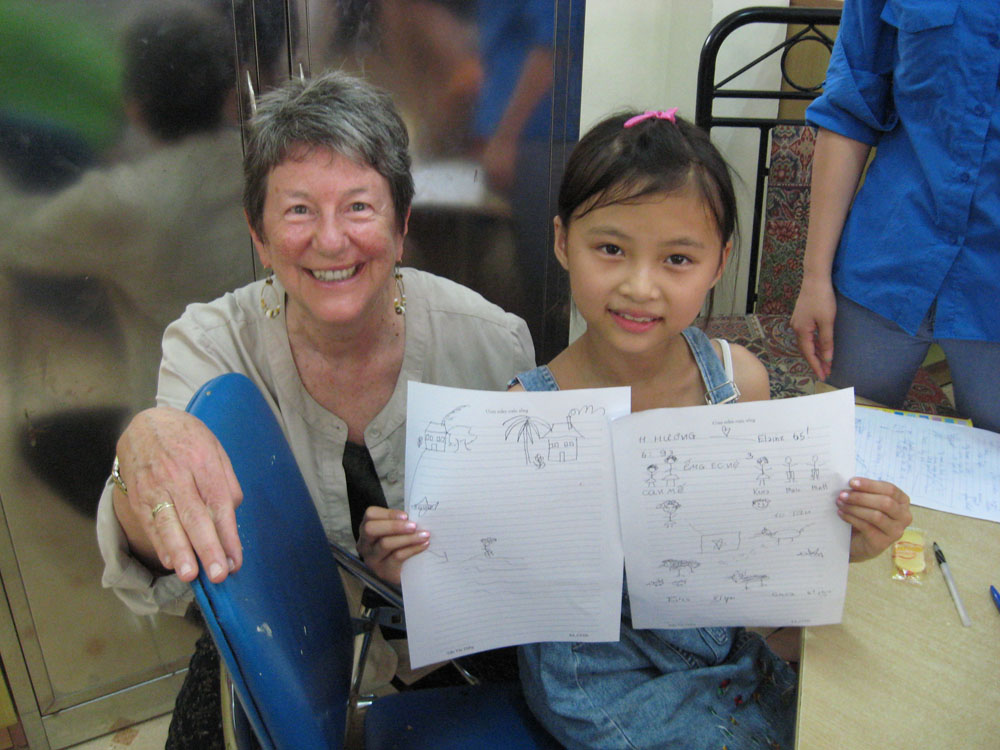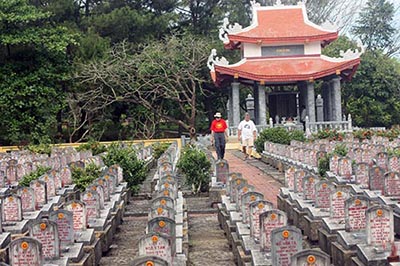 Download PDF of this full issue: v43n2.pdf (20 MB)
Download PDF of this full issue: v43n2.pdf (20 MB)From Vietnam Veterans Against the War, http://www.vvaw.org/veteran/article/?id=2481
 Download PDF of this full issue: v43n2.pdf (20 MB) Download PDF of this full issue: v43n2.pdf (20 MB) |
As we made our way in the darkness of the Vinh Moc tunnels, I ran my hands over the well-worn rock of the narrow passageway. Every few yards, light from someone's small flashlight would illuminate tiny caves. These, our guide Truc explained, were dwellings for entire families.

|
|
Elaine Elinson with new friend Huong, 11, at Friendship Village, HaNoi. |
Half-way through the length of the tunnel, we came upon a cave with life-size figures in it. A woman lying on a cot, another woman bending over her, a baby in her arms. This was the maternity room. Seventeen babies were born underground: as US artillery bombarded Quang Tri, seventeen new lives emerged. St. Augustine said that hope has two beautiful daughters: anger and courage. These seventeen babies were born of hope.
I remembered in college seeing a grainy, black- and-white French film about the tunnels, unsteady camera shots of an operating theater, school and living quarters deep underground. We all marveled at the determination and tenacity of the Vietnamese.
Forty years later, as I inhaled the damp air, and gingerly stepped on the slippery stones, I had the same feeling I had as I touched the wallpaper in the Anne Frank House in Amsterdam. This was the same stone that had sheltered Vietnamese villagers and the Viet Cong as they fought for liberation. We were touching history, we were touching hope.
If I was so overcome, I wondered how the veterans on our delegation were feeling. Gayle Hodges had flown troops out of Travis Air Force Base to Viet Nam in 1966-67, landing in Saigon on Christmas Eve. Chris Jamison was a crew member on a M42 Duster at various fire bases along the DMZ in 1970. Mike Kerber was drafted and spent 8 months in the artillery of the 101st Division in the mountainous area of the A Shau Valley.
From April 18 to May 2, we were part of a group of 13 members of Veterans for Peace who traveled to Vietnam as part of an ongoing effort to understand and heal the legacies of the war. We were guests of the Veterans for Peace Chapter 160, comprised of US veterans who now live and work in Vietnam, and the Vietnamese Veterans Association.
We focused on two specific scourges of the aftermath of the war, the impact of Agent Orange on several generations of Vietnamese children and the toll taken by unexploded ordnance, which, even today, injure and maim farmers in rice paddies and children in rural villages.
Though the hot war ended almost four decades ago, the American war of aggression continues to take its deadly toll. Most Americans, including myself and others on our delegation, were not aware of the way the Vietnamese people continue to live with this lethal legacy.
As we journeyed from Hanoi, to Quang Tri province, Hue, Da Nang, Na Trang and Ho Chi Minh City, we learned how Vietnam has struggled to rebuild in the face of great devastation — and how welcoming the Vietnamese people are to Americans who come in friendship. At one of our first meetings in Hanoi, Ambassador Nguyen Tam Chien of the Vietnam Union of Friendship Organizations, explained, "The virtue of peace has been enforced through our history of war"
On our first day in Vietnam, Gayle and I walked through the Women's Museum in Ha Noi.

|
We were moved by the stories of women guerrillas, many of whom had been imprisoned — some in tiger cages built by the French, tortured and executed. We read letters, hastily written in pencil on pages torn from a spiral notebook, about how much they missed their children. We saw items in the display cases, a teapot, a pistol, an embroidered scarf used for smuggling covert messages that were the few, vital possession of courageous women fighters.
I remembered a t-shirt I wore to anti-war demonstrations in San Francisco: it was white with a red silkscreen of a woman guerrilla fighter in an ao-dai and a conical hat. In one hand she cradled her baby, in the other an AK-47. Here were their real stories, their scarves, and their embroidered sewing boxes containing ammunition.
At Friendship Village, a serene countryside oasis outside of Hanoi's bustle that houses a school and home for children disabled by their families' exposure to Agent Orange as well as a rest center for veterans, we met several women veterans. Though we could not understand each others language, we embraced in solidarity. A Vietnamese veteran with a chest full of medals insisted on taking one off his uniform and pinning it on the shirt of Chuck Searcy, vice-president of Veterans for Peace 160 who has lived in Vietnam for 20 years.
"Did you see," Gayle asked me in her warm Texan drawl, "that when he pinned the medal, a drop of his blood fell on Chuck's shirt? That was one of the most memorable moments of this trip for me," she said.
Mike Kerber, a peace activist from Chicago, had a similar feeling. "When we met Vietnamese vets, some of whom fought in the same area where I was, they put their arms around us and we were filled with warmth. It was a fabulous feeling to experience this kind of forgiveness that you don't see much of in the United States.
"This trip has brought a peace of mind about the war that I could never get before," Kerber added.
As a former artilleryman in the hills of the A Shau Valley, Kerber was especially moved by our visit to Khe Sanh, where more than 100,000 tons of bombs (equivalent to five Hiroshima-size atomic bombs) were dropped in 1968 during the massive aerial bombardment assault, and 158,000 large-caliber shells rained down from the surrounding hills. This was almost 5 tons for every one of the 20,000 NVA soldiers there. At the Truong Son National Cemetery, where 20,000 graves mark the remains of Vietnamese soldiers and civilians who died in defense of the Ho Chi Minh Trail, Kerber and other members of the delegation lit incense and paid their respects to the war dead.
The bombs and artillery continue to take their toll. As we stood in a desolate field near Nan Bieu village in Quang Tri province, under a blue tarp to protect us from the blazing sun, Colonel Bui Trong Hong, a 30-year veteran of the Peoples' Army of Viet Nam, explained how teams detect and remove unexploded ordnance, inch by inch. At the nearby provincial Mine Action Center, we learned how just after the war injuries from unexploded ordnance were widespread, as thousands of people, impoverished by the war and the debilitating embargo, sought out weapons to sell for scrap metal.
Today, school children come to the Mine Action Center to learn how to stay safe. Planters made from artillery casings are filled with aloe and bougainvillea. "Swords to plowshares," remarked Searcy, whose organization Project RENEW, helps clear weaponry, provide livelihoods in cattle raising and mushroom farming to impacted families, and fund the educational center.
Chris Jamison, a labor union organizer from Syracuse, New York, could hardly contain his anger as we listened to the US contractors explain the multi-million dollar remediation project at the former Da Nang Air Force Base. Jamison, who was stationed near the DMZ, had been warmly welcomed into the simple homes of families whose children, debilitated from genetic mutations caused by Agent Orange, cannot speak, see or even sit up. As he climbed the ladder to look at the expensive clean-up site, Jamison murmured in a troubled voice, "Too little, too late."
For a decade, the United States sprayed 80 million liters of poison on Vietnam -- 61% of which was Agent Orange containing dioxin, one of the deadliest chemicals known to man. It claimed more than 3 million victims, including children of the third and fourth generation. Hundreds of thousands have died, and 200,000 victims currently receive a small monthly subsidy from the Vietnamese government. Because most victims cannot work, and often need full-time care, these families are the poorest of the poor.
Jamison was more impressed by the work of VAVA, the Vietnam Association for Victims of Agent Orange, that has 3,500 chapters around the country to mobilize support and assistance to victims of Agent Orange and their families. He was moved by the dedicated teachers in the schools for disabled children and the doctors at Hoa Binh Village at the Tu Du Hospital who care for children whose families cannot cope. Those are the more fortunate ones. In a small room at the hospital, there are rows and rows of shelves with jars containing fetuses that could not survive because they were born without brains or other vital organs.
"I still can't understand why most Vietnamese (but I'm sure not all) seem to forgive us -- notably me as an American soldier -- for the death and the destruction we inflicted upon their families, their communities, and their nation during the war," said Jamison. "I know of no other people as courageous and persevering as the people of Vietnam, especially the war veterans, unexploded ordnance teams, Agent Orange victims and their caretakers who we were honored to meet."
In Hoi An, Gayle and I bought candles in paper cut-out boats that were being sold along the banks of the Thu Bon River under the colored lanterns of the ancient Japanese Bridge. A young girl told us to make a wish and showed us how to lower them into the water on a long pole. We made a wish for the children we had met in Friendship Village, who danced for us at the DAVA Center, who slapped palms with us at Tu Du Hospital, and who lay silently on straw mats in villages in Quang Tri and Hue. We said a prayer for peace, and our tiny flames joined a stream of other candles, bringing a glow to the dark waters.
Elaine Elinson is a San Francisco-based journalist who traveled with the anti-war FTA Show in Southeast Asia in 1971.
Veterans for Peace is organizing now for the 2014 tour: March 29 to April 12, 2014. If you are interested in joining, please contact: Tour Coordinator in the US - Nadya Williams E-mail: nadyanomad@gmail.com Home: (415) 362-0162 Mobile: (415) 845-9492.